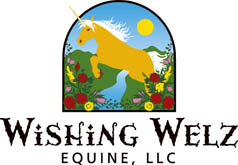2003 International Conference
for Strasser Hoofcare
Tuebingen, Germany
November 4th to November 8th, 2003
by Yvonne Welz
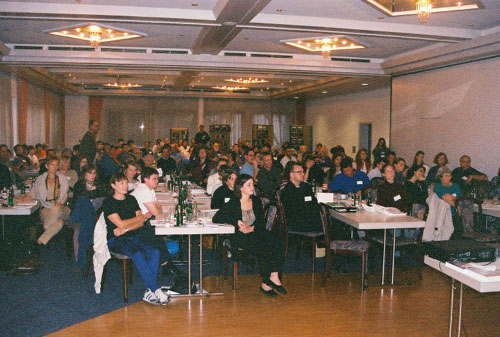
The crowded conference room was filled with 200 enthusiastic horse
people from around the globe.
Imagine 200 horse people from all over the world, brimming with
enthusiasm for barefooted horses and natural horse care, gathering together
with such great dynamic energy, in an event that can only be described as truly
inspirational.
For James and I, least memorable has to be the flight there and
back. Something we would really like to forget! 10 1/2 hours cramped on a tiny
plane seat, eating terrible food...you get the picture. But once we arrived
in Germany, the picturesque green countryside (such a startling contrast to
our desert home) enveloped us. The town of Tuebingen is stunning, awe-inspiring
architecture, bustling with people - and simply everyone we saw there was thin,
healthy, and gorgeous! The streets are so safe, it appears that crime is non-existent,
and people walk and bike everywhere both day and night. There is an air of trust,
in both businesses and ordinary people, that seems so unusual to us Americans.
Everyone was honest and trustworthy, and assumed you to be likewise. How refreshing!
Day 1 (Monday)
The Hufklinik
Visiting Dr. Strasser's Hufklinik (Hoof Clinic) is an experience
I will never forget. We walked down a country lane to get there from our car,
and I noticed that all the pasture fences are electric tape. A dense, giant
dark forest borders the luminous green pastures. I've heard tales of Dr. Strasser's
high-speed, wild rides through that forest (from people who've accompanied her).
They say she rides like the wind.
The Hufklinik itself was on a section of land much smaller than
I imagined (though I'd been told that is a large plot of land for Germany!)
It is laid out in such a nice design, making use of all available space. The
Hufklinik building was an indoor riding arena before Dr. Strasser converted
it. The inside barn is laid out with rubber mats, and the outside walking path
is paved with rubber bricks. There are plans to continue improving the facilities,
including a poured-in rubber floor. Around 10 horses are kept in the Hufklinik
at one time, and there were about that many on site, which the Hoofcare Specialists
(CSHS or soon to be called SHP) utilized as part of their re-certification test
trimming.
Day 2 (Tuesday)
Siteseeing
While many foreigners were just arriving at the airport that day,
we were free to tour, since we had arrived early for the re-certification day.
We spent the day walking around Tuebingen, touring the castle on the hill, and
oh yes, eating, eating, eating all day long!
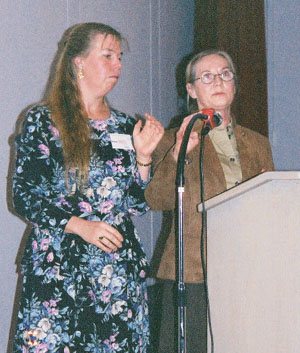
Sabine Kells and Dr. Strasser start off the Conference.
Day 3 (Wednesday)
Introduction of the International Groups
Well, much to my great surprise, and with only a couple minutes
notice, I ended up giving the very first presentation of the day, for the United
States. I do remember staring out at the sea of faces, all 200 of them, and
wondering what to say...but then the words came. Afterwards, everyone told me
I did a great job, but frankly, I can't remember what I said!
The presentations that followed were excellent, from Canada, United
Kingdom, Australia, New Zealand, Germany, South Africa, Netherlands, Czech Republic,
Russia, Denmark, France, and the Scandinavian countries including Norway, Sweden,
Finland. The problems and issues that each country has faced seem universal.
Many countries reported that they were working quietly and trying to avoid any
conflicts, and that seemed to work very well. Interest in Strasser Hoofcare
and barefooted horses is rapidly growing all over the world.
Day 4 & 5 (Thursday & Friday)
Presentations
The Conference presentations were simply outstanding. I believe
the audience was literally riveted for the entire two days. The questions posed
after each presentation were extremely sophisticated, reflecting the very well-educated
audience.
Here is a short description of each presentation:
Biophysical Basics for Meridians and Acupuncture, Dr.med.vet
Andreas Roesti, Switzerland. This was so interesting, he included information
to support the explanation of meridians, discussed properties of water and salt,
the aura that can be photographed, the "vacuum" in the physical body,
the "tone law" which defines the world by a sound wave, and provided
some details of how he treats for hoof problems with acupuncture.
Horse Nutrition, Dr.med.vet Dorothy Meyer, IWEST, Germany.
Sabine Kells presented Dr. Meyer's work, as she could not be in attendance.
The information was outstanding, and went into great detail about many feeding
and nutritional concepts that are often argued about. Breaking down in detail
the attributes of oats, it becomes clear that they are an ideal feed for our
captive horses when more protein and/or energy is needed. Whole oats are ideal
because of the high proportion of mucilaginous substances, husks and starch
digestibility, with an ideal fat content. As far as feeding oils-she reports
that horses cannot digest the oil before it reaches their large intestine, where
the oil will then kill bacteria, and could lead to massive damage of the intestinal
flora.
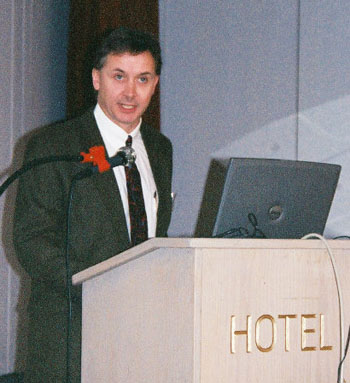
Dr. Carl Kirker-Head of Tufts University presents information about the stifle
joint.
Stifle Operations in Horses, Prof. Dr. Carl Kirker-Head,
USA. His presentation went into great detail about the workings of the equine
stifle joint, and the surgical corrections currently available. He also covered
OCD and degenerative joint disease.
Chiropractics in Horses, Dr. Rowan Killmartin, Australia.
His presentation included a constant reference to barefooted horses, and how
correcting the hoof can work hand-in-hand with chiropractics to create outstanding
results. He went in detail about how back pain can arise from hoof imbalances.
Connections between Hoof Form and the Whole Organism, Dr.
Strasser. A continuation of the work we all know and love from her, she demonstrated
how the hoof affects every organ in the body, as well as the horses' posture,
musculature, and metabolism.
The Tooth-Jaw Connection as a Parallel of Coffin Bone Suspension,
Dr. Erich Korber, a German dentist. He presented details about the connective
tissue of the tooth root, and gives the analogy to the coffin bone, and how
regeneration of this connective tissue is very similar.
Hoof Orthopedics for the Two-Legged, Dr. med. Sigred Herzog,
Germany. This human doctor presented the dangerous results of poor foot wear
in humans, including high heels.
Analgesic Drugs and their Mechanism of Action, Dr. Per
Holmberg, Sweden. Such a lively discussion followed this presentation, I believe
we even surprised Dr. Holmberg with our extreme interest! Analgesic drugs were
explained in detail, from a scientific point of view (instead of drug company
point of view). The effects of each NSAID was discussed in great detail, including
the negative side effects of all the most popular ones.
Accidents with Shod Racehorses, Dr. Maria Klein, DVM, Germany.
Dr. Klein presents her observations of racing barefoot before the rule was changed
in Germany, in 1995, to require that racehorses be shod on all 4 feet. The decision
was made based on the idea that barefoot racing was dangerous. Since then, there
has been no decline in number of horses falling per year on the track -- not
to mention how serious the injury must be to a jockey stepped on by a shod horse
vs. a barefoot one. When facts are looked at, it makes no sense that horses
must be shod for safety.
Animation of a Hoof Model, Glenn Ramsey, New Zealand. This
fascinating presentation detailed Glenn's long-range plans to produce a computerized
model of the hoof, that can be used for research and testing. It was amazing
to see the complexity of this project, and we applaud Glenn for taking this
on - what a fantastic resource this will become.
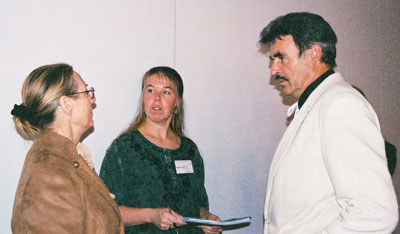
Dr. Strasser and Sabine Kells chat with Fred Rai.
Is Riding Bitless Dangerous? Fred Rai, riding instructor
and trainer, Germany. Mr. Rai presents his riding system, based on natural horsemanship
principles, that encourages relaxed, confident recreational riding for horse
and rider without the use of a bit, spur or whip.
Dr. Cook was to present "Fear of the Bit, a Welfare Problem
for Horse and Rider," but was unable to attend the conference. His presentation
was included in the conference booklet.
The conference was simply a huge success. This is just a short
summary of events, and I plan to go into more details on all the happenings,
with more lengthy summaries of each speaker, in the next issue of The Horse's
Hoof. Lots more photos to come, also!
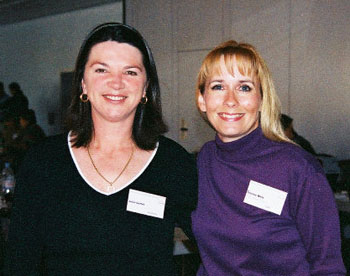
Julie Leitl, SHP from Australia, on the left, and that's me on the right. Hi
Ysabelle!
The next International Conference for Strasser Hoofcare is planned
for November 2006, once again in Tuebingen, Germany.
©2006 by The Horse's Hoof. All rights reserved. No part of
these publications may be reproduced by any means whatsoever without the written
permission of the publisher and/or authors. The information contained within
these articles is intended for educational purposes only, and not for diagnosing
or medicinally prescribing in any way. Readers are cautioned to seek expert
advice from a qualified health professional before pursuing any form of treatment
on their animals. Opinions expressed herein are those of the authors and do
not necessarily reflect those of the publisher.





